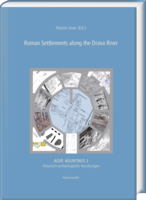|
|
more titles of the subject:
Download:
Please note: With adding digital Products to your cart
the payment will be handled via PayPal. The download will be provided after the payment is confirmed. The second Aguntum workshop focused on the location of the Municipium Claudium Aguntum on the upper reaches of the Drava. The contributions published in volume 3 of the series Ager Aguntinus investigate to what extent the Roman settlements along the river route were in contact with each other – from the source of the Drava to its confluence with the Danube. Archaeological findings from Austria, Slovenia and Croatia suggest possible connection points.
The importance of river routes as trade routes in Roman times is indicated by the research presented on the traffic routes along the Po in northern Italy and the Ljubljanica in Slovenia. Not least on the basis of corresponding findings from Aguntum and Aquileia, it becomes clear that river ports are to be expected in Roman cities. In this way, the volume offers not only a compilation of Roman findings from these very settlements, but also a discussion of the significance of river trade, even beyond the Drava River. Im Fokus des zweiten Aguntum-Workshops stand die Lage des Municipium Claudium Aguntum am Oberlauf der Drau. Die in Band 3 der Reihe Ager Aguntinus publizierten Beiträge gehen der Frage nach, inwieweit die an der Flussroute liegenden römischen Siedlungen, von der Quelle der Drau bis zu ihrer Einmündung in die Donau, miteinander in Kontakt standen. Archäologische Befunde aus Österreich, Slowenien und Kroatien weisen auf mögliche Verbindungspunkte hin. Wie wichtig Flussrouten als Handelswege in römischer Zeit waren, zeigt sich anhand der vorgestellten Forschungen zu den Verkehrswegen entlang des Po in Oberitalien und der Ljubljanica in Slowenien. Nicht zuletzt aufgrund entsprechender Befunde aus Aguntum und Aquileia wird deutlich, dass in römischen Städten mit Flusshäfen zu rechnen ist. Der Sammelband bietet auf diese Weise nicht nur eine Zusammenstellung römischer Befunde aus eben diesen Siedlungen, sondern genauso eine Auseinandersetzung mit der Bedeutung des Flusshandels, auch über die Drau hinaus. |
|||||||||||||||||||||||||||||||||||||||||






